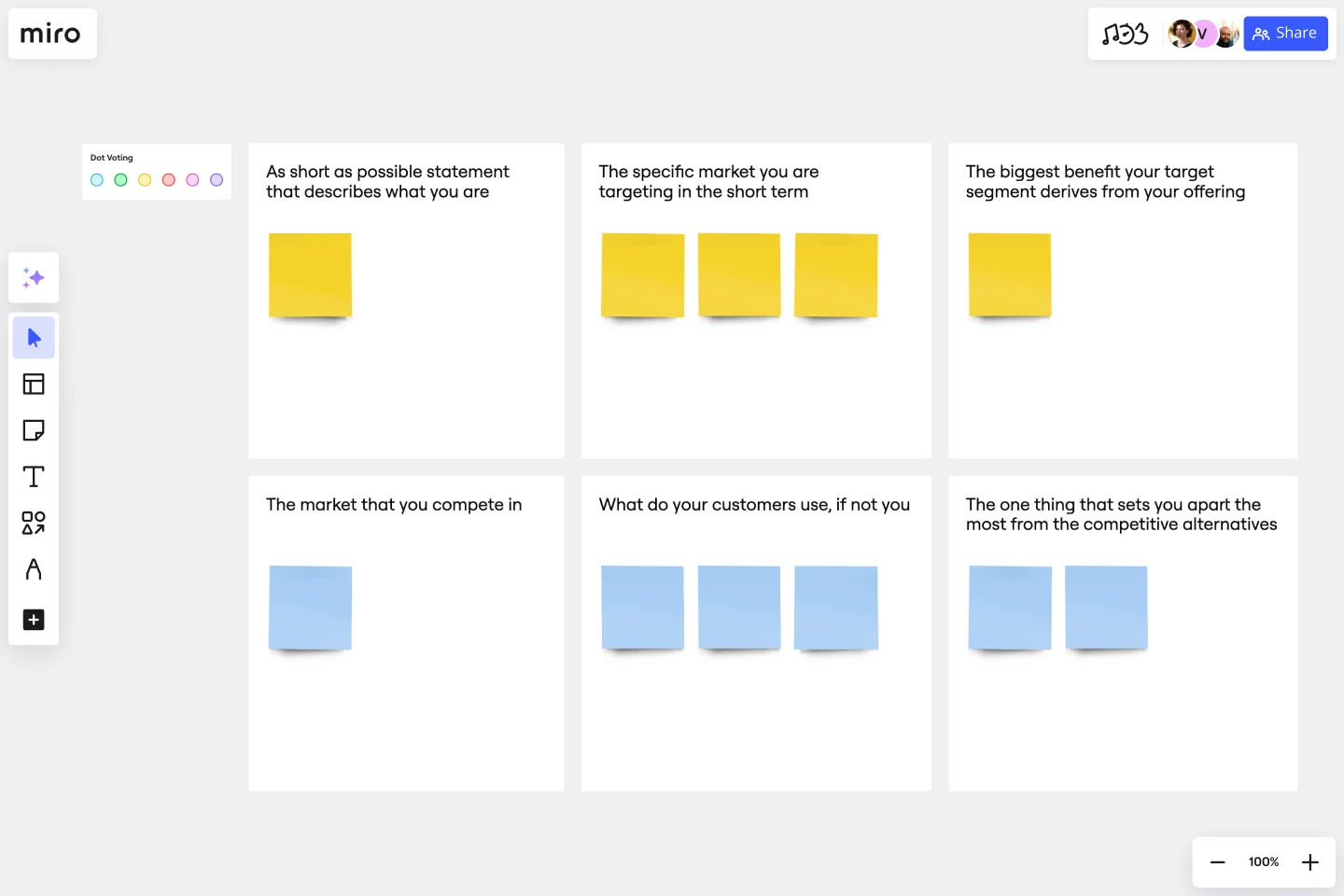Product Positioning Template
Create your strategy for launching a new product or entering a new market with the product positioning template.
About the Product Positioning Template
The success of your company largely depends on the market you are operating in. So, it is necessary to conduct a product positioning exercise before you start building products and planning strategies. This exercise is intended to determine where your company and its offering stands in the market. Although the format of these exercises may differ, it is generally advised to have these objectives in mind:
Define your customer: Who would buy your product or service?
Define the problem: What pain point are you solving for your customer? How does this problem impact your customers? It can also be useful to think about your customers’ experience of this problem. What emotions might they feel when they encounter the problem? This will help you market and design your product offering.
Define key market characteristics: What else do your customers usually buy? How do they buy it? What makes them switch products?
List the other companies in your market: Are these companies your potential partners? Potential competitors? What is their business model? How have they been successful? How have they failed? What is their biggest pain point?
Design an elevator pitch: Your pitch should encompass your customers, their pain points, and how your product is uniquely positioned to solve their problem.
Narrow down your competitors: Now that you have your pitch list your competitors and their strengths and weaknesses relative to your offering.
How to use the product positioning template
The product positioning template is fully customizable, so you can adapt it to your specific needs. Here is a step-by-step on how to use the template:
Step 1: Invite your team members to collaborate on your board.
Step 2: Add the product positioning template. Brainstorm and upload all relevant information to add to each section of the template.
Step 3: If needed, use a Talktrack to share ideas beforehand, and start discussions with your colleagues async.
Step 4: Gather your findings and organize your final product positioning.
Step 5: Present your product positioning directly from the board, print them out, or share them with other stakeholders to gather their feedback.
When should you conduct product positioning exercises?
It is recommended to carry out product positioning exercises whenever launching a new product or entering a new market. Additionally, it is advisable to periodically conduct product positioning to keep up-to-date with the market trends and to stay informed about your product.
Get started with this template right now.
Blue Ocean 4 Actions Framework Template
Works best for:
Leadership, Decision Making, Strategic Planning
For entrepreneurs, so much comes down to new users—how to attract them, impress them, and convert them to loyal customers. This template, designed by the authors of Blue Ocean Strategy: How to Create Uncontested Market Space and Make the Competition Irrelevant, will help you maximize value for you and your customers alike. Using the template’s four steps (divided into easy columns), you’ll easily evaluate your products in more innovative ways and make sure money is being spent in areas that really matter.
Design Research Template
Works best for:
UX Design, Design Thinking, Desk Research
A design research map is a grid framework showing the relationship between two key intersections in research methodologies: mindset and approach. Design research maps encourage your team or clients to develop new business strategies using generative design thinking. Originally designed by academic Liz Sanders, the framework is meant to resolve confusion or overlap between research and design methods. Whether your team is in problem-solving or problem space definition mode, using a research design template can help you consider the collective value of many unrelated practices.
App Development Canvas Template
Works best for:
Market Research, Product Management, User Experience
Ever noticed that building a successful app requires lots of players and moving parts? If you’re a project manager, you definitely have. Lucky for you, an app development canvas will let you own and optimize the entire process. It features 18 boxes, each one focusing on a key aspect of app development, giving you a big-picture view. That way you can fine-tune processes and get ahead of potential problems along the way—resulting in a smoother path and a better, tighter product.
Three-Hour Brand Sprint Template
Works best for:
Marketing, Workshops, Sprint Planning
Before customers will believe in your brand, your team has to believe. That’s where brand sprints work wonders. Popularized by the team at Google Ventures, a brand sprint will help your team sort through all different ideas about your brand and align on your brand’s fundamental building blocks—your values, audience, personality, mission statement, roadmap, and more. Whether you’re building a new brand or revamping an existing one, brand sprints are ideal for trigger events such as naming your company, designing a logo, hiring an agency, or writing a manifesto.
Cross Functional (Swimlane) Chart
Works best for:
Flowcharts, Mapping, Diagrams
The Cross Functional (Swimlane) Chart template offers a visual tool for mapping out processes or workflows with multiple stakeholders or functional areas. It provides swimlanes for organizing tasks and responsibilities by department or role. This template enables teams to visualize process flows, identify handoffs, and improve coordination and collaboration across functions. By promoting transparency and accountability, the Cross Functional (Swimlane) Chart empowers organizations to streamline workflows and drive cross-functional alignment effectively.
Fishbone Diagram for Marketing
Works best for:
Fishbone diagram
Identifying the root causes of marketing challenges is essential for effective strategy development. The Fishbone Diagram for Marketing template helps you systematically explore factors affecting your marketing efforts. Categorize potential causes into areas such as market research, product positioning, promotional strategies, and distribution channels. This structured analysis enables your team to pinpoint and address issues, optimizing marketing campaigns.
